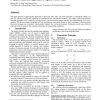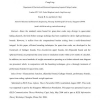13041 search results - page 10 / 2609 » Simulating space and time |
TIT
2008
13 years 8 months ago
2008
This paper presents a quasi-random approach to space-time (ST) codes. The basic principle is conceptually simple, yet still very effective and flexible regarding the transmission ...
TIT
2008
13 years 8 months ago
2008
Since the standard union bound for space-time codes may diverge in quasi-static fading channels, the limit-before-average technique has been exploited to derive tight performance b...
GLOBECOM
2007
IEEE
14 years 2 months ago
2007
IEEE
—In this paper, a novel error probability analysis of orthogonal space-time block coding (OSTBC) over independent but not necessarily identical Hoyt (Nakagami-q) fading channels ...
VTC
2006
IEEE
14 years 2 months ago
2006
IEEE
— The combination of space-time block codes (STBC) and spatial multiplexing (SM) schemes has the advantages of diversity gain and high data rate. For such STBC/SM hybrid systems,...
CORR
2008
Springer
13 years 8 months ago
2008
Springer
To combine the high power efficiency of Continuous Phase Modulation (CPM) with either high spectral efficiency or enhanced performance in low Signal to Noise conditions, some auth...


